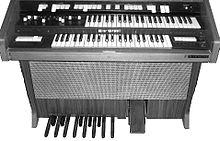Glossary of jazz and popular music
This is a glossary of jazz and popular music terms that are likely to be encountered in printed popular music songbooks, fake books and vocal scores, big band scores, jazz, and rock concert reviews, and album liner notes.
1x10" 1x12" 1x15" 1x18" 1x21" 2x10" 2x12" 2x15" 2x18" 4x10" 4x12" 4-track (or "four-track") 5-string (or five-string) 6-string (or six-string) 7 inch 7-string (or seven-string) 8-string (or eight-string) 8-track 8x10" 10 11th 12 inch 12-string 13th 33 1/3 45 78 303 808 A section accordion acid rock ad libitum (commonly ad lib; Latin) alt (English), alt dom, or altered dominant altissimo alto amp analog arpeggio arrangement art rock artist and repertoire (A&R) as is autotune
B-section back-beat backmasking ballad barre chord or bar chord bass bassline beat bend bin or bass bin binary bleeding, bleed, or bleed-through block chords blow boogie bootleg blue note blues board bomb break bridge broken chord brushes bubbles cabinet (cab) cadence call and response capo changes channel chicken pickin' chord chorus chromatic scale clavinet clean clean channel click track clipping clonewheel or clonewheel organ coda colosseum ending combo comping comping takes compressor condenser microphone or condenser mic cover or cover song crossfader crossover crunch cut time dead decibel (dB) demo desk DI or DI unit digital signal processing (DSP) double-time feel doubling downtuned or detuned dragging drive drop drop 1
ear candy effects unit encore (Fr) engineer fader fakebook fall falsetto feedback fiddle fill (English) flat foldback forte or (f) fortepiano (fp) fortissimo (ff) fortississimo (fff) front of house (FOH) four on the floor fuzz bass ghostwriter gig gliss half-time feel harmony vocals or harmony parts harp harpsichord homophony head honky-tonk hook horn horn section house band ignore changes inside intro J-bass jam or jam session jazz standard or standard keyboardist keyboard amp lay out lead lead bass leading note Leslie line line in line out marcato (marc.)'
roadie Roland rolled chord rushing sample or sampling scratch segue semitone session musician, session player, or session man shake sharp shred sidefills sideman or sidemen sibilance sign sit in skins slapping or slap bass snake solid-state solo break solo soli soprano standard tuning stompbox stage piano Stratocaster (Strat) Surf Ballroom subwoofer (sub) sweetening sweet spot syncopation tablature (tab) tacet take tech Tele (Telecaster) tempo tenor ticky tack tight sound timbre time track trainwreck or train wreck transcription or note-for-note solo tribute band tremolo tube amplifier or valve amplifier tubs tuner turnaround unison utility player vamp vamp till cue vanity record 'verb virtuoso vocal score or piano-vocal score voicing VU meter wah-wah pedal walking bass wall of sound weekend warrior whammy bar woodshed

















